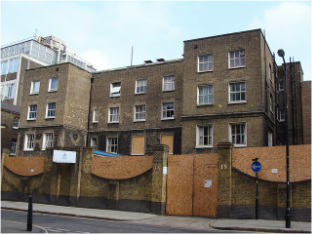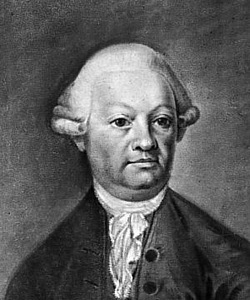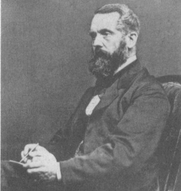 The Strand Workhouse, Cleveland Street If you walk down Cleveland Street, in the heart of the London's Fitzrovia, you come across a boarded-up old building which until 2006 housed the out-patient department of the Middlesex Hospital. Architecturally the Georgian building has little merit and its only feature is a stone relief of an old man pointing to an inscription reading: "Avoid idleness and intemperance". 150 years ago this building was the Strand Union Workhouse and those entering it were under probably no illusions as to their fate. The workhouse master, a Mr Catch, shared a close resemblance to the fictional Mr Bumble. Charles Dickens lived on Cleveland Street, which was then known as Norfolk Street, and it isn't difficult to see how the writer's inspiration for Oliver Twist probably came from his personal knowledge of the workhouse just seven doors away from his house. In the latter part of 1854 Dr Joseph Rogers was busy working as a surgeon apothecary (GP) in Soho during a cholera outbreak. A friend told him, "you will live to regret this outbreak, it will ruin the neighbourhood and your practice for many years to come.. and then you will have nothing to do". This prediction came true and the following year with his practice dwindling Dr Rogers found himself as the medical officer of the Strand Workhouse. In Victorian Britain poverty was rooted in illness and old-age and conditions in the Strand Workhouse were terrible. The beds were so close to each other that it was only possible to get out at the end. The infectious sick were housed with the non-infected in an atmosphere of poor ventilation, lack of sanitation, poor nutrition and supervised by drunken pauper nurses who were without qualification. In this atmosphere suffering, disease and despair abounded. Rogers appealed to the Guardians to remove the laundry to the rear yard of the workhouse, enlarge the cellars to provide better accommodation for sick children and he change the gruel-only diet fed to single mothers for nine days after giving birth. One of Roger's most difficult problems was the workhouse master, George Catch. He and his wife treated the inmates badly and also obstructed most of his efforts to improve conditions. Eventually Rogers finally managed to secure his dismissal on the ground of extreme neglect which resulted in some relief of the inmates who were apparently jubilant at his departure. Following the Crimean war there was interest in sanitary problems and the observation that paupers were more likely to die if they entered the workhouse led, Thomas Wakley, the editor of the Lancet established a special commission to investigate the sanitary state of workhouses and the care of the sick poor. In 1865 they visited the Strand Workhouse commenting that it had but one redeeming feature "the care and skill of the surgeon and of the master and matron, and the improvements in ward management which the zeal of these officers and the benevolence of the lady visitors have effected. They were less complimentary on the environment stating that the buildings are atrociously bad as a residence for sick persons, and they are incapable of real improvement by any cobbling process. Joseph Rogers founded the Association for the Improvement of London Workhouse Infirmaries and by 1867 the Lancet campaign had borne fruit with the passage of the Metropolitan Poor Act which provided new infirmaries separate from workhouses. During the next decade some 20 new hospitals were built in London providing an extra 10,000 beds.
References
http://www.workhouses.org.uk/Strand/ Richardson, R & Hurwitz B. Dr Joseph Rogers and the reform of workhouse medicine BMJ 299 1507 Richardson, R. Dickens and the Workhouse: Oliver Twist and the London Poor. Oxford University Press. http://www.clevelandstreetworkhouse.org Rogers, J. Reminiscences of a Workhouse Medical Officer
0 Comments
 If a patient complains of breathlessness one possible cause is collection of fluid around the lungs called a pleural effusion. This diagnosis can be made easily by tapping the chest with the fingers - a technique known as percussion. Percussion was invented by Joseph Leopold Auenbrugger (1722-1809), the son of an innkeeper from Gratz, in Austria. In 1751, after completion of his medical studies, he became assistant physician at the Holy Trinity and Spanish Military Hospital in Vienna. He discovered that tapping his fingers on the patient's chest produced sounds of varying pitch depending on what structure was underneath. As a child he had seen the barrels in his father’s cellar being tapped to find out how much wine they contained and in his work on percussion he wrote that “empty casks are resonant but they become dull when full of wine”. By systematic percussion over the chest he observed that the note was dull over the heart. Likewise if the pleural cavity surrounding the lungs became filled with fluid, the sound of the percussion note was so muffled it became completely or stony dull. He went on to correlate his percussion findings with conditions found at post-mortem and to prove the existence of fluid inside the chest by withdrawing it with a trocar. Auenbrugger practised the percussion technique for seven years before, in 1761, he published his treatise titled: “Inventum Novum ex Percussione Thoracis Humani Ut Signo Abstrusos Interni Pectoris Morbos Detegendi” which translates as “New Invention, by means of percussing the human chest, as a sign of detecting obscure disease in the interior of the chest”. In the 18th Century publication of anything medically often invoked criticism rather than adulation from colleagues. In the preface of his book he wrote: “In making public my discoveries respecting this matter, I have been actuated neither by an itch for writing, nor a fondness for speculation, but by the desire of submitting to my brethren the fruits of seven years observation and reflection. In doing so, I have not been unconscious of the dangers I must encounter, since it has always been the fate of those who have illustrated or improved the arts and sciences by their discoveries, to be beset by envy, malice, hatred, detraction and calumny”. Auenbrugger’s method of percussion was to strike the chest wall directly with the extended fingertips. He found that the note produced was better if the shirt was tightly drawn across the chest (like the covering of a drum) or if the physician’s hand was covered with a leather glove. Today we lay one hand flat on the chest and strike the back of its middle finger with the tip of the middle finger of the other hand. This prodcues a better percussion note and makes it less uncomfortable for the patient compared to striking the chest directly with the fingertips. After his publication the percussion technique was ignored for many years. Baron van Swieten, Professor of Medicine at Vienna University and Auenbruggers teacher, did not mention it in his 1764 treatise on fluid around the lungs in pulmonary tuberculosis and other contemporaries like Vogel confused it with the Hippocratic practice of succussion whereby the patient was shaken vigerously to detect the presence of fluid and air in the thorax. One favourable review appeared describing the discovery as “a torch that was designed to illumine the darkness in which diseases of the thorax had up to this time lain concealed". The poor reception of his book and being dismissed from the Spanish Military Hospital did not seem to harm Auenbrugger's his career prospects. Private practice prospered and he was popular at the Court of Vienna where he was enobled by the Emperor Joseph II with the title “Edler von Auenbrugger". He was also an accomplished musician and at the Emperor’s request wrote the libretto for a comic opera, Der Rauchfangskehrer (The Chimney Sweep) for the court composer Salieri. Percussion remained hidden until 1808 when Jean Nicholas Corvisart, the personal physician to Napoleon, translated Auenbrugger's work from Latin into French and then the technique rapidly came to world-wide attention and use. Today percussion remains a basic clinical skill learnt by all medical students and practised by doctors on a daily basis. |
Dr Richard BogleThe opinions expressed in this blog are strictly those of the author and should not be construed as the opinion or policy of my employers nor recommendations for your care or anyone else's. Always seek professional guidance instead. Archives
August 2023
Categories
All
|

 RSS Feed
RSS Feed

